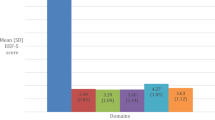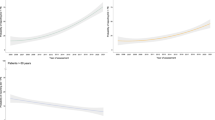Abstract
The prevalence estimates of erectile dysfunction (ED) vary considerably across studies. These differences may be attributed to used definitions of ED. Quantitative data on the effect of different definitions of ED on the prevalence are lacking, because precise information on the used definition and questionnaire is often absent. Aim of this study was to quantify the effect of using different questionnaires for ED on the prevalence estimates. In all, 5721 mail surveys on sexual problems and ED were sent to all men (aged>18 y) in 12 general practices in the middle of the Netherlands of which 2117 were completed. The questionnaire contained Enigma (WHO), International Index of Erectile Function (IIEF), Cologne Erectile Inventory (KEED) and one question (Boxmeer, Krimpen). The prevalence of ED based on the various questionnaires and the effect of these questionnaires on risk factor relationships was compared. IIEF gave the highest age specific and overall ED prevalence, KEED the lowest. The difference in prevalence was 16.8%. The agreement (kappa coefficient) between the various ED definitions varied from 0.52 (IIEF & KEED) to 0.95 (Enigma & Boxmeer). The number of risk factor relations were similar for the Dutch studies, reduced for the IIEF and KEED. This study provides evidence that differences in questionnaires to assess ED have a considerable effect on the (age specific) prevalence estimates and little on the risk factor relations. The number of questions of the survey appears not to be responsible for differences in the prevalence of ED and risk factor relations, however they affect the response rate. Uniform use is strongly recommended, since a ‘golden standard’ for ED assessment (by questionnaire) is lacking. A short questionnaire with one or two questions is recommended for example the one from the Boxmeer-study. These data may be used to adjust (age-specific) prevalence rates comparing ED prevalence in the open population across studies.
This is a preview of subscription content, access via your institution
Access options
Subscribe to this journal
Receive 8 print issues and online access
$259.00 per year
only $32.38 per issue
Buy this article
- Purchase on Springer Link
- Instant access to full article PDF
Prices may be subject to local taxes which are calculated during checkout
Similar content being viewed by others
References
Boer LJ de et al. Prevalence and risk factors of erectile dysfunctions in the general population: a critical appraisal, J. Epidem, in press.
Prins J et al. Prevalence of erectile dysfunctions: a systematic review of population-based studies. Int J Impot Res 2003; 14: 422–432.
McKinlay JB et al. International differences in the epidemiology of male erectile dysfunction. Int J Clin Pract Suppl 1999; 102: 35.
Melman A, Gingell -JC . The epidemiology and pathophysiology of erectile dysfunction. J Urol 1999; 161: 5–11.
Bortolotti A, Parazzini F, Colli E, Landoni M . The epidemiology of erectile dysfunction and its risk factors. Int J Androl 1997; 20: 323–334.
Spector IP, Carey MP . Incidence and prevalence of sexual dysfunctions: a critical review of the empirical literature. Arch Sex Behav 1990; 19: 389–408.
Lewis RW . Epidemiology of erectile dysfunction. Urol Clin N Am 2001; 28: 209–216, vii.
The NIH consensus panel. NIH-consensus on erectile dysfunction. JAMA 1993; 270: 83–89.
Wagner G et al. Erectile dysfunction (WHO). 1st International consultation on Erectile Dysfunction (WHO, ISSIR, SIU) 1999.
Rosen RC . Brief Male Sexual Function Inventory for urology. Urology 1996; 47: 782–783.
Rosen RC et al. The International Index of Erectile Function (IIEF): a multidimensional scale for assessment of erectile dysfunction. Urology 1997; 49: 822–830.
Rosen RC, Cappelleri JC . The sexual health inventory for men (IIEF-5): reply to Vroege. Int J Impot Res 2000; 12: 342–343.
Vroege JA . The sexual health inventory for men (IIEF-5): reply to Cappelleri and Rosen. Int J Impot Res 2000; 12: 297–298.
O'Leary MP et al. A brief sexual function inventory for urology. Urology 1995; 14: 697–706.
Day D, Ambegaonkar A, Harriot K, McDaniel A . A new tool for predicting erectile dysfunction. Adv Ther 2001; 18: 131–139.
Braun M et al. Epidemiology of erectile dysfunction: result of the ‘Cologne Male Survey’. Int J Impot Res 2000; 12: 305–311.
Corty EW, Althof SE, Kurit DM . The reliability and validity of a sexual functioning questionnaire. J Sex Marital Ther 1996; 22: 27–34.
Blanker MH et al. Erectile and ejaculatory dysfunction in a community-based sample of men 50 to 78 years old: prevalence, concern, and relation to sexual activity. Urology 2001; 57: 763–768.
Bosch R et al. Erectile dysfunction in a community-based sample of men aged 50–74 years: prevalence and somatic and social factors. Eur Urol 1999; 35(Suppl 2): 66.
Meuleman EJH et al. Erectiestoornis: prevalentie en invloed op de kwaliteit van leven; het Boxmeer-onderzoek. [Erectile dysfunction: prevalence and influanece on the quality of life. The Boxmeer study]. Ned Tijdschr Geneeskd 2001; 145: 576–581.
Rudolf M, Backer de G, Kostler M, Meyer de JM . Prevalence and correlates of erectile dysfunction in a population based study in Belgium. Eur Urol 2002; 41: 132–138.
Rosen RC, Capelleri JC, Gendrano N . The international Index of Erectile Function (IIEF): a state-of-the-science review. Int J Impot Res 2002; 14: 226–244.
Author information
Authors and Affiliations
Corresponding author
Rights and permissions
About this article
Cite this article
de Boer, B., Bots, M., Lycklama a Nijeholt, A. et al. Impact of various questionnaires on the prevalence of erectile dysfunction. The ENIGMA-study. Int J Impot Res 16, 214–219 (2004). https://doi.org/10.1038/sj.ijir.3901053
Received:
Revised:
Accepted:
Published:
Issue Date:
DOI: https://doi.org/10.1038/sj.ijir.3901053
Keywords
This article is cited by
-
Cardiovascular disease risk, vascular health and erectile dysfunction among middle-aged, clinically depressed men
International Journal of Impotence Research (2010)
-
Prevalence of erectile dysfunction among middle-aged men in a metropolitan area in Germany
International Journal of Impotence Research (2007)



